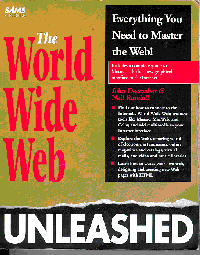Volume 9, Issue 2, 1995

Book Reviews
The World Wide Web Unleashed John December and Neil Randall SAMS Publishing, USA, 1994, pp. 1058, œ31.50. ISBN 0 672 306174The World Wide Web (WWW or Web) is a relatively new addition to the Internet but the introduction of graphical browsers such as Mosaic and Netscape have ensured its fast growing popularity with users and created a media hype not seen since, well not since the last media hype.
The World Wide Web Unleashed is a comprehensive guide to the Web from first principles, to designing and creating your own web pages and a look into what the future for a "webbed society" might hold.
The book is a collaboration between John December, who is well known for his work on computer mediated communication (cmc) on the Internet and Neil Randall, author of Teach Yourself the Internet: Around the World in 21 days. There are also a number of chapters from other contributors, including Thomas Boutell author of the WWW FAQ (frequently asked questions) and David Woolley creator of one of the first conferencing systems - PLATO Notes. This collaborative effort has produced some duplication between chapters, the basic operations of Mosaic are dealt with fully in Chapter 10 and then repeated in Chapter 15.
Explanations of terms and concepts are also sometimes repeated, however rather than prove a problem this may work to enhance the users' understanding of these concepts. The book is aimed at all levels of experience and you should find something to interest you, whether you are a network novice or a dedicated Web surfer. It is separated into six sections starting with an introduction to the WWW, a review of some of the browsers available for different platforms and a section on navigation tools and techniques. There is a guided tour of the sort of information that is actually available for different sectors, tips on designing and implementing your own web and finally some of the trends and issues of providing information on the Web. The book also briefly deals with the "edges" of the Web i.e. the tools that you can access through the Web such as ftp, gopher and telnet. The authors devote a lot of time and coverage to the Mosaic browser because at the time of writing it was by far the most popular browser around. However rapid development is a characteristic of the Internet and Mosaic has quickly been superseded by Netscape in popularity (with an estimated 70% of the market share).
The style of writing is informal and relaxed and good use of screen shots are made throughout the book. The authors offer a realistic view to what is actually possible using the Web. This is a useful counterbalance to the over enthusiastic claims that the Internet can provide you with information on anything and everything. There is a lot of information available but this information is not necessarily correct or of any significant value. One of the most difficult tasks faced by users is to sieve through the junk that is out there to find the information "jewels", to help with this the auths provide a checklist of key points to help judge the accuracy of networked information and techniques to help you successfully search out the information you want.
The appendices include a world-wide listing of Internet access providers, glossary and a directory of interesting sites. The book also offers a support site on the web itself that provides updates, selected sections from the book and links to various applications, sites and pages demonstrating good design principles. Ironically there is a typing error in the book for the URL (network address) of the site - the correct address is:
URL: http://www.rpi.edu/~decemj/works/wwwu.html
[This site seems to no longer exist- Web Editor May 1998]
At over a 1,000 pages long the World Wide Web Unleashed does not really qualify as a handy pocket reference to the Web and the background information may prove distracting if you just want to get to grips with the basics. However as a comprehensive guide it is invaluable, especially for anyone thinking of providing information on the Web. The book's real strength lies in the sections on designing and creating a web site. December constantly stresses the importance of careful planning and good design, which anyone who has spent time browsing the Web will fully appreciate.
Debra Hiom
Centre for Computing in Economics, University of Bristol

